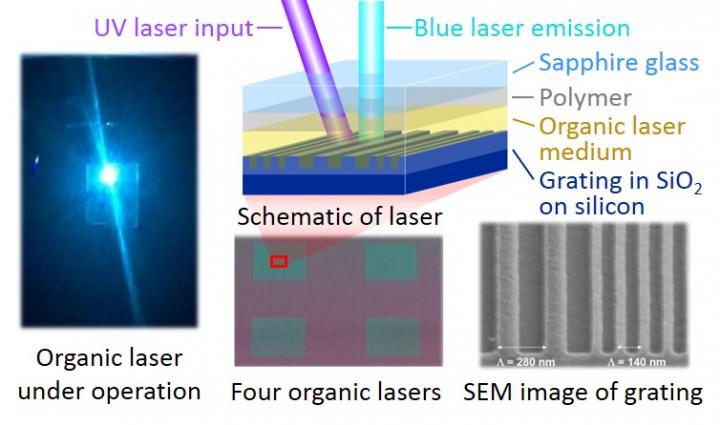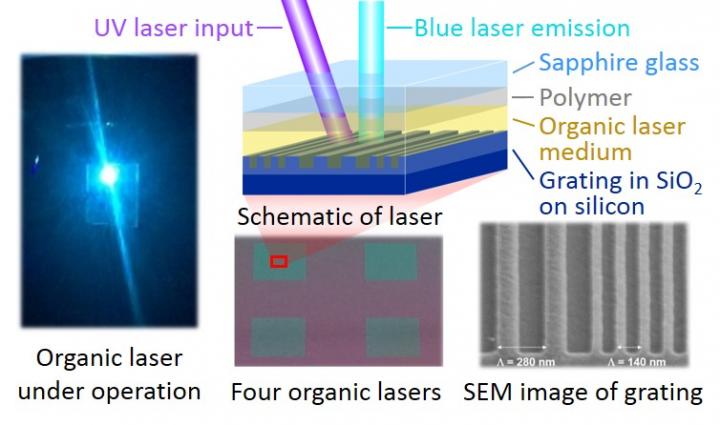
Credit: Atula S. D. Sandanayaka and Willam J. Potscavage, Jr.
New research could make lasers emitting a wide range of colors more accessible and open new applications from communications and sensing to displays.
Researchers at Kyushu University's Center for Organic Photonics and Electronics Research (OPERA) reported an optically pumped organic thin-film laser that can continuously emit light for 30 ms, which is more than 100 times longer than previous devices.
Unlike the inorganic lasers commonly found in CD drives and laser pointers, organic thin-film lasers use a thin layer of organic molecules as the laser medium, which is the material in the device that actually produces lasing by emitting and amplifying light when excited with an energy source. In this case, the energy source was intense ultraviolet light from an inorganic laser.
A very promising feature of organic thin-film lasers is the possibility to more easily achieve colors that are difficult with inorganic lasers. By designing and synthesizing molecules with new structures, emission of any color of the rainbow is possible.
"People have been studying organic thin-film lasers for a long time, but degradation and loss processes have greatly limited the duration of emission," says Atula S. D. Sandanayaka, lead author of the paper in Science Advances reporting the new results.
The researchers were able to reduce these problems and extend the duration of the lasing by combining three strategies.
To reduce major losses originating from the absorption of laser emission by packets of energy – called triplet excitons – that build up in the organic laser medium during operation, the researchers found an organic laser medium with triplet excitons that absorb a different color of light than that emitted by the laser.
Thermal degradation caused by heating of the lasers during operation was reduced by building the devices on a crystalline silicon wafer and gluing a piece of sapphire glass on top of the organic laser medium with a special polymer.
The silicon and sapphire, which are good heat conductors, help to quickly remove heat from the devices while at the same time encapsulating them.
Finally, through optimization of a frequently used grating structure – called a mixed-order distributed feedback structure – placed under the organic laser medium to provide optical feedback, the input energy needed to operate the lasers was reduced to new lows, further lessening the heating.
"These devices really operate at the extreme, so we have to keep finding new tricks to eliminate any inefficiencies and prevent the devices from burning themselves out," says Professor Chihaya Adachi, director of OPERA.
Using these simple devices in conjunction with inorganic lasers is promising for more easily achieving colors that are difficult to produce using common lasers, with applications in spectroscopy, communications, displays, and sensors.
Development is still ongoing to sustain the emission for even longer durations, but as for what is next?
"Our ultimate goal is realizing organic thin-film lasers that directly use electricity as the energy source, and this is an important step in that direction," says Adachi.
###
For more information about this research, see "Towards continuous-wave operation of organic semiconductor lasers," Atula S. D. Sandanayaka et al., Science Advances 3, e1602570 (2017). DOI: 10.1126/sciadv.1602570
This research was performed as a part of the Adachi Molecular Exciton Engineering Project funded by the Exploratory Research for Advanced Technology (ERATO) program of the Japan Science and Technology Agency (JST) under JST ERATO Grant Number JPMJER1305, Japan.
Media Contact
William J. Potscavage, Jr.
[email protected]
81-928-026-920
http://www.cstf.kyushu-u.ac.jp/~adachilab/lab/
############
Story Source: Materials provided by Scienmag





